Man is the only rational animal, and we do not know if that is the reason why he is the only being that wears clothes. From the beginning of time to the present day, clothing has undergone numerous transformations that, in most cases, have been due to the discovery of new fabrics and materials and, undoubtedly, the trends that fashion dictates in general.
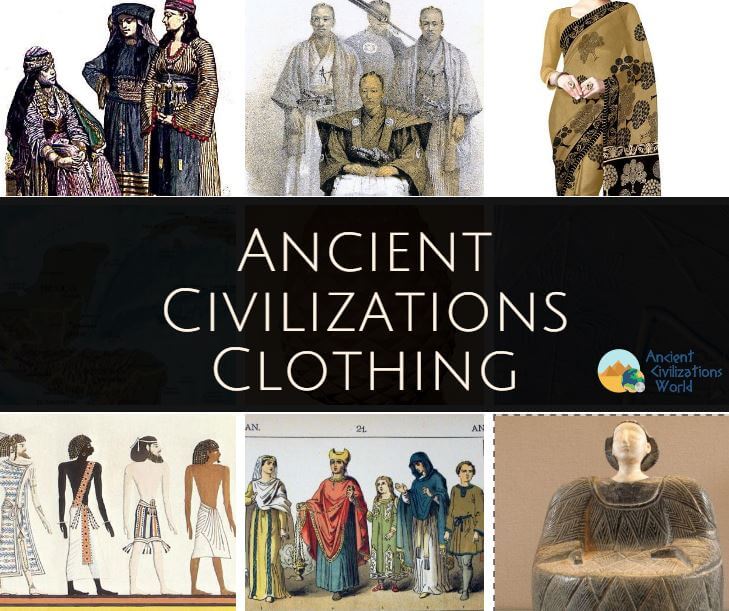
Ancient Civilizations Clothing
Contents
Sumerian Clothing
In the Ancient Middle East, a division was made regions of valleys and plains like Mesopotamia, Arabia, Palestine, and Syria. The oldest civilization in Asia is Mesopotamia, in which Sumer or Sumeria (lower region) was established.
Native clothing originated in the third millennium (2500 BC). The primitive influence of cloths that wrap around the body, loose garments, and suits mixed with the contributions of many diverse civilizations. The Sumerians wore skins and hides with the fleeces of sheep and goats on the outside with certain advances to the Paleolithic and Neolithic ages of Europe and Africa.
Women’s clothing
- Hanging shawl in dress
This one is worn with adornments of knotted and curly fringes, it is long and is used in royal dress.
2. Kaunakes dress and gown
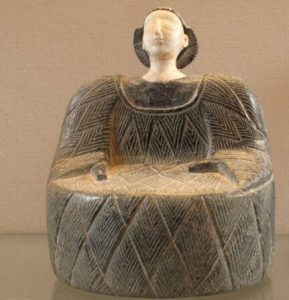
This is a garment that covers the shoulders and arms, like a layer with smooth edges. The bodice is formed by horizontal sections with pieces of vertical skin.
3. Female dress pendant
It is a kind of rectangular shawl with fringes and frills on the edges.
4. Female luxury dress
It consists of a tunic embroidered at the lower end with fringes that widen on the floor, on top a rolled shawl is placed, embossed with metallic embroidery. The sleeve is short at the elbow and the neckline is held by a splint.
5. Skirt
It reaches the middle of the leg, being the most ancient dress of the Sumerians.
6. Kaunakes Skirt
It is adorned at the back with an animal skin that is tightened at the hips with a belt. This often forms a tail.
Men’s clothing
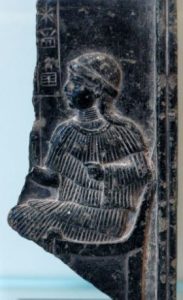
The man wore a fur skirt or wool material in a stylized pattern, which is sectioned by horizontal patches. At the beginning of the third millennium, a shawl of narrow tufts was wrapped around the waist in a long skirt. The king wore a long kaunakes, and the priests wore it below the knee. The men of the town or servants wore a shortened skirt that showed the left leg up to the knee; it could be fastened by an embroidered belt.
In rich classes, the Sumerian shawl is worn as a separate garment and is considered to be the oldest garment made of wool.
The dress of the two sexes could present differences through the adjustment of their garments; The fabrics formed small circles or a square figure and were adorned with pearls.
Hairstyles and headdress
- Hair was tied with a ribbon or bandage over the forehead.
- Men were bearded with long tufts, first pointed and then squared and with sideburns. The men wore headdress as head protection made from folded fabric. The soldiers wore copper helmets portraying monkeys, hair, and ears.
- They wore gold ornaments adorned with pearls, combs, made with flowers and leaves carried on top of wigs, earrings in the form of a moon, rings, leaf-shaped collars and pins made of gold.
- For the more elegant classes the hair is tied around the ears and braided, they wear turbans made by a rolled up scarf and a hood with a point in the crown made of wool or leather.
Babylonian and Assyrian Clothing
- Babylon (2105-1240 BC)
- Assyria (1200-340 BC)
In Babylon, there existed the wool and linen weavers industry, although flax and cotton were more restricted, these fibers dominated the mantles and robes of men’s and women’s clothing.
In the fabrics of Assyria, wool dominates in green, red, dark purple, blue and brown. Specifically, luxury dress was green with red and yellow borders and a fringed trim.
Assyrian Dress

The dress of the people of Assyria was based on robe and mantle making various modifications and differentiating the social hierarchy.
In the middle class, the tunic reached the feet and sometimes they were short, showing only the knee, folds were placed on one side of the tunic, covering the leg with high boots.
In the higher classes, long tunics are shown descending to the feet, edges with fringes and braids, with characteristic embroideries and woolen fabric.
The high dignitaries of the court were different from the rest of the people for wearing girdles that cross the chest and that were dyed purple or other tones to indicate their power.
Royal garments are worn on top of their first garment, the robe, which was spiraled along the body, adorned with a fringe embroidery with detailed geometric figures or flowers. This mantle is passed over the left shoulder through a belt, to be rolled up as a skirt over the hips (this was also used in religious ceremonies).
Kandis
It was a tunic that covered the first garment and was distinguished by embroideries and tassels at the ends of the tunic.
Kaunakes
Mantle under a dress that could be embroidered with geometric figures (mainly worn by the kings).
Babylonian Dress

It is represented by a tunic of thread that reaches to the feet, on top of it another woolen tunic is placed and wrapped with a small white layer (a garment that was dominant among men).
In the feminine garments, the robes were predominantly embroidered with fringes; For the women of the town, they wore long dresses, girded with a belt or band.
The man was also dressed, but shorter, with long, narrow sleeves. They continued to wear tufts of animal skin on their garments as was influenced by the Sumerian luxury dress.
Both in Assyria and in Babylon, free or married women were obliged to cover themselves with a veil when they left.
Tops and Accessories
- The men had long, curly hair and long beards; The hair of the king was adorned with threads of gold in the form of a net.
- The kings of Babylon cut a scroll in a conical shape with an ornament that protrudes into a point and left two strips hanging down to the waist. Another adornment is a tall cylindrical tiara that forms a row of metallic feathers.
- The people of the royalty cover their head with a turban or tarbush which is decorated with a tiara with horns (this one is used by the position of pontiff).
- The jewels that were most appreciated were long earrings in the form of walnuts or rings, earrings in the shape of a cross, necklaces of several rows with talismanic elements and for arms and cuffs, bracelets adorned with geometric figures or flowers. For hair, they used ribbons of gold.
- The warrior dress was formed by high boots, the bodies were protected by coats (metallic mesh) made of wool and quilted linen.
- The archers wore a long robe of metal scales tightened with a belt. For the cavalry and heavy infantry, they wore a pair of trousers, a breastplate of scales, and tight leggings.
- The chiefs of the army were distinguished by having two stripes crisscrossing their breasts, as protection for the head they wore helmets of leather and metal.
Ancient Persian Clothing
Persian attire, which took on historical significance in the middle of the sixth century BC, was based on that of the Assyrians and the Babylonians, with some new elements of their own.
The typical garment was the “Kandis”, a kind of wool or silk tunic imported from the Far East, which was adapted to the body and had wide sleeves. The great king and the satraps or governors wore only the Kandis and the monarch wore purple. Generally, he wore the skirt or broad robe supported by a belt. For the first time in the history of mankind, the use of underwear appears. The Persians were the creators of embroidery application, a technique that was introduced in Europe after the Crusades. They wore flexible yellow leather shoes, anatomically shaped, tied at the ankles with straps and buttons. The men had long, curly hair and beards, and the nobles dusted themselves with gold dust. The kings adorned their heads with tiaras and mitres. Another typical garment was the white cotton cloth, wrapped around the head and neck. Little is known about women’s clothing since women lived a life of seclusion.
Ancient Egyptian Clothing
Clothing in Ancient Egypt was a direct consequence of the climate: warm and dry, and the way of life, outdoors.

Clothes were exclusively made of linen, although at first cotton was used, linen was imposed based on the belief that it was purer, and it was cultivated exclusively for textile purposes. The preferred color was white, although they could have some designs on the edges.
Wool was known but was considered impure since all animal fibers were taboo. Since the conquest of Alexander the Great, wool began to be used in everyday garments and continued to be banned in temples and shrines where the priests were to wear white linen.
Popular attire
Peasants, workers, and modest people used to wear a loincloth, and if they wore it, they wore only the shenti, which was worn by men of all social statuses, consisting of a kind of skirt that was wound at the waist. And they wore it with a leather belt. During the New Kingdom, around 1425 a. C., they began to use a light tunic, or sleeveless shirt, as well as a kind of pleated doublet.
Attire of the nobility
Among the people of high standing the piece was embroidered with decorations and placed on a breech or tunic. On top of the schenti, the people of distinction wore a sort of short skirt, forming small folds, which, to leave the house, were exchanged for a tunic with sleeves or without them, both of fine texture. To cover the head of both sexes, they wore a false wig, and men a particular headdress, nemes, which was formed with a square canvas, made with a striped cloth whose most common colors were blue and yellow, adjusted to the forehead and with drapes on the sides.
The royal dress was well documented, they dressed similarly to the rest of the village, though using distinctive symbols such as the Egyptian scepter and crown.
Women’s clothes

The feminine dress remained similar for almost three thousand years, modified only in some details. The women wore the long skirt with a very high waist, like a long, tight dress, one piece, fastened with two suspenders, which were sometimes wide and covered their breasts. They also wore a sort of short cloak covering their shoulders. The way of putting on the robes was quite varied, giving the impression of being different clothes. Sometimes they wore very fine muslin, sometimes they were dyed and painted fabrics, decorated with various motifs that mimicked, for example, a plumage like the wings of Isis. Working women wore larger clothes, some of them were also naked.
In the Roman domination, in the tombs of the Copts, tunics of Roman form and with adornments equal to those used by the Christians of the catacombs (the clavi and calliculae) were found, while others of them lack all sewing ( Seamless tunics)
Footwear
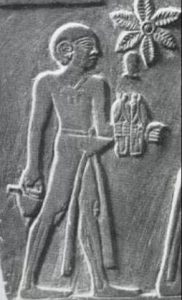
Footwear could be domestic or ceremonial and used in certain situations and by certain people. They wore sandals made of reeds or vegetable fibers, which for kings and mighty men could be made of other materials, like braided leather, and wore all kinds of ornaments, ending up in a tip stooped upwards. The priestly class used them as Papyrus.
The “sandal-bearer” was an important administrative function. The incumbent was in charge of preparing the archives, arranging what was necessary before a trip, picking up the demands of the audience, etc. (In our time, this role is similar to that of the private secretary of a minister or a party president). The one who had the title of sandal-bearer of the pharaoh was one of the most influential men of the country.
In everyday life the ordinary man was barefoot and only on a special occasion wore sandals: when he had to go somewhere he would wear his sandals in his hand or tie them to the end of a cane to put on his shoes when he reached the destination.
Ancient Hebrew Clothing
The use of bangs is a matter of importance because it was not a matter of fashion or style it was “a mandate of God”, that the dress of the Ancient Hebrews included the east fringe. It indicated “holiness and separation of the chosen people”, they wore blue hinges on the fringe, this could have been on the sleeves and hem of the dress, the “boxes of shelter” were not an obligation because the law did not require it. Its use was an interpretation of the Jewish masters of some texts that gave a literal interpretation of how to apply the sacred words of God.
The young men at the age of seventeen wore the “manly toga”. The Roman women in the morning wore the “interula” or underwear, which was made of cotton.
They used a “stola”, matron’s outfit, just as the citizen’s toga was. The last garment of the ladies was the “palla” or mantle they placed on their body without buttons, pins or needles. Certain social classes wore a sleeveless robe that covered the knees
The manual workers and the shepherds wore a Greek-style tunic, the eximis, very short and devoid of sleeve on the right arm. During the reign of the empire, tunics embroidered with adornments of gold and silk appeared, the Roman footwear was a sandal used by both sexes.
The Romans liked the jewels and used pearls, diamonds, emeralds and rubies of oriental origin
If they were in mourning, the color of the cloak was changed to black.
Ancient Greek Clothing
The clothes in Ancient Greece were very simple. The garments were obtained from a rectangle of cloth and used to be wrapped or draped; The sewing was minimal. The fact that woolen garments were predominant means that most of the clothing had a whitish hue.
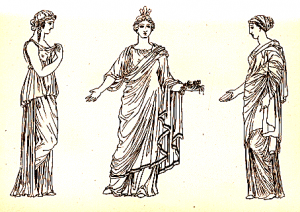
The essential garment of Greek dress is the Chiton, or tunic, worn by both men and women. It was a piece of woolen cloth, rectangular and large, wrapped around the body, covered the left arm and left the right uncovered. It was fastened on the left shoulder or on both shoulders by pins or brooches (fibula).
The chiton of the women was made with a finer cloth than the men’s. A common garment in women was the Doric peplo: a simple rectangle of woven cloth. They wore draping around the body and it was held on their shoulders with pins or fibula; The leftover fabric was bending upwards. On top of the tunic, the women wore the male mantle, the himation, fastened on one shoulder or the other, and from which they dropped the end in front.
The chiton of men was much wider than that of women. Subsequently, this chiton was replaced by a shorter version that came only to the knee.
Another indispensable element of the men’s wardrobe was the himation. It was wrapped around the torso, passed under the left arm and held on the right shoulder so that the excess cloth fell on the right arm and could be held with several small pins.

Both men and women wore sandals, made of wrought leather or purple. The boots were the usual footwear of soldiers, hunters, and active men.
The men’s hats were very varied (the truncated, the small-winged and the extended truncated). The piles were a wingless hat, made of felt or wool, which was sometimes worn under the helmet. The women wore handkerchiefs, which were placed so that they turned two heads.
The ancient Greeks admired the blonde tonality and some people struggled to clear their hair by washing it with yellow flowers or using a special ointment. Long hair was considered effeminate and only acceptable for elderly, young or children. The women wore it with a line in the middle, wavy and backward, with their ears uncovered. Sometimes it was picked up by a ribbon, strip, diadem or string of beads.
Ancient Roman Clothing
What we know about the way of life of the Romans focuses on the upper classes. The Romans divided their clothing into two main categories: the garments, garments that went through the head and were removed only to sleep, and amictus, clothing that was rolled or draped around the body.
The woman’s clothing was made of light materials such as cotton and silk from India and in a variety of colors such as deep blue, yellow and red, sea green and light pink. The indispensable item was the stole. It was a garment that reached the ankle and had wide sleeves, often fastened with locks and girded at two points, under the chest, with a closure called cingulum, and at the hip, with a succincta, a belt width. Underneath the women could wear a subucule, a loose dress without sleeves, as well as the strophium, a bodice made of fabric without starch.
The men dressed simply. The basic short-sleeved tunic was worn at home. It could also be carried in public places with a sash, when it was provided with a purse to store money and other valuables. At first it was worn to the height of the knee, but later it was extended to the ankle.
The Roman garment of greater renown is the toga. They wore it as a short skirt and later on a tunic. It came to measure, approximately, 5’5 meters long and 3`5 meters wide. Its enormous size implied that to wear it was necessary to help a slave. Like the tunic, it was a garment reserved for Roman citizens, especially the well-to-do classes; Neither slaves nor strangers could wear it.

The outer garment most used was lacerna, a cloak made with a rectangular piece of wool with rounded ends, wrapped around the shoulders, fastened to these or the neck with a clasp, and sometimes had a hood that could be removed and put. Other outer garments were the sagum, similar to a blanket in different shades of red wool, worn by the soldiers and the paenula, a layer of wool for the rain carried mainly by the peasants.
As for footwear, most of the citizens wore the carbatina, a sandal made of a smooth piece of leather that covered the natural shape of the foot and was fastened with a leash. In times of bad weather, they wore open or closed boots. Women had fewer options than men, they wore sandals, shorts (boots at the ankle), and boots that reached far above the calf.
The women wore rings, bracelets, necklaces, earrings and elaborate brooches.
Most of the Roman citizens wore short hair and combed forwards, baldness was considered a deformity, so bald men wore wigs or pieces of fake hair glued to the bald parts. The slaves, as a symbol of their situation, wore long hair and did not shave. The freed slaves, on the other hand, shaved their heads and wore a wool cap as a mark of distinction. The women at first had their hair quite natural, with a stripe in the middle and gathered at the nape of the neck with a bow or ponytail. Subsequently, it could be curled, curled or slightly rolled up and down at the nape of the neck. Another very common style was wearing a fringe of very dense curls.
Ancient India Clothing
In the immense Indian civilization, several civilizations and cultures have coexisted, and, with them, the most diverse vestments.

The sculptures and engravings present images dressed in a short skirt called “dhoti”, which was quite similar to the loincloths of primitive peoples.
Indian clothing, they adopted the shirt, the head girdle and the mantle.
The women’s clothing consisted of a short bodice or jacket fastened at the back.
In addition to the famous shawl and cashmere coats, and especially the typical “sari” long cloth of rich silk forming beautiful folds, they surrounded the head and the chest and descended to the hips and the waist.
Ancient Arabic Clothing
The people of Yemen wore shirts or kamis. Underneath they used a few loosely knit canvas, breeches called schirwal.
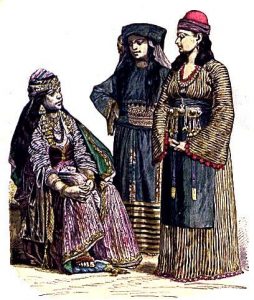
Muhammad commanded them to wear the “irham”, every Muslim should dress on his pilgrimage to Mecca.
To cover their heads, the Arabs used a turban called an amamah.
The shoes they used were tanned leather and untanned camel leather sandals.
The woman’s undergarments were similar to those of the man and in the outer dress she emphasizes a broad and vaporous dress called “tserb”, as well as the blanket, it was a garment that covered the whole body.
They had peculiar means of showing off, as always and no matter what the variety of fabrics, the delicacy of fabrics, and the ornamentation.
It reflected the fickle fashion, already in the plurality and difference of clothes, already in the delicacy and color of the fabrics, already in the combinations of use and bearing, not forgetting the changing forms of beards and hairstyle, footwear, jewels, and medals.
Ancient Japanese Clothing
In 283, two women traveled from Korea to Japan to teach silk fabric and brocades.
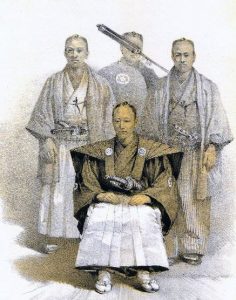
In the year 300, the dresses of the Japanese emperors were made with Chinese silk. At first, the dress was similar to the Chinese but the emperor Yuryaku ordered reforms in the dress for priests, military civilians, and nobles.
In addition to being differentiated by color, they changed the design and size of the sleeves and even the shape of the hairstyle.
The “kasane” or loose tunic was used along with a short sack called “akome”.
The “hakama” was a loose shirt that came only a few centimeters from the knees and showed “shita-gutsu” or socks.
The ladies have always worn the “kimono” which is a loose gown, with long sleeves and a waist belt, on the back they wore a kind of bow or cushion. As footwear, they used wood sandals with a forward heel and a very high back.
